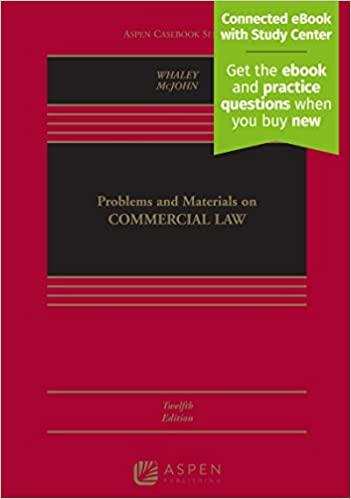Question
Tutorial 9 Short Answer Questions 1.Taking into account the test for insolvency, is a company insolvent merely because it does not have sufficient cash to
Tutorial 9
Short Answer Questions
1.Taking into account the test for insolvency, is a company insolvent merely because it does not have sufficient cash to pay its debts?
2.When can a director, who has breached s588G, use the reasonable grounds to expect solvency defence?
3.What difficulty does the statutory derivative action address?
4.What are the elements that must be established for an action under s232?
5.When the court makes an order under s233 that the majority members purchase the shares of the minority members, how is the value of the shares established?
6.Contrast the types of conduct which will be considered to be in breach of s232 with behaviour that will not be considered to breach s232.
7.How does the court assess the validity of constitutional amendments to expropriate members' property rights?
8.Who can enforce the duty to avoid insolvent trading?
9.What consequences can arise for directors who contravene s588G?
10. What presumptions of insolvency may be used in recovery proceedings by liquidators?
11. In what circumstances may a transaction involving a related party be set aside if entered into prior to liquidation?
12. What potential liability may a bank or other major creditor face if they attempt to renegotiate their lending arrangements with a debtor company shortly prior to insolvency?
13. How do you determine whether someone is a member of a company? Does it matter for obtaining members' remedies if the person was previously a member but is now no longer a member?
14. How can a member enforce a breach of directors' duties? Who may be paid compensation if the action is successful?
15. What remedies may a member seek in respect of a breach of the company's constitution?
16. Explain the difference between a member's personal rights and company rights.
17. How does the court satisfy itself that it is 'just and equitable' to wind up a solvent company?
18. What is the meaning of good faith in s237(2) (SDA)?
19. How does the court establish unfair prejudice or unfair discrimination?
20. When can a statutory injunction be used to provide a member with a remedy?
21. Explain the principle of fraud on the minority. How is it different from minority oppression?
22. When is it not permissible to alter the corporate constitution?
Step by Step Solution
There are 3 Steps involved in it
Step: 1

Get Instant Access to Expert-Tailored Solutions
See step-by-step solutions with expert insights and AI powered tools for academic success
Step: 2

Step: 3

Ace Your Homework with AI
Get the answers you need in no time with our AI-driven, step-by-step assistance
Get Started


